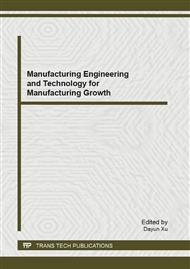[1]
J. David Porter, Richard E. Billo, Rucker Robert. Architectures for integrating legacy information systems with modern bar code technology. Journal of Manufacturing Systems. 23 (2004) 256-265.
DOI: 10.1016/s0278-6125(04)80038-4
Google Scholar
[2]
Manuel D. Rossetti, Gordon M. Clark. Estimating capacity loadings from workcenter arrival and departure events. Journal of Manufacturing Systems. 17 (1998) 65-76.
DOI: 10.1016/s0278-6125(98)80010-1
Google Scholar
[3]
Roger Lindau, Kenth Lumsden. The use of automatic data capture systems in inventory management. International journal of Production Economics. 59 (1999) 159-167.
DOI: 10.1016/s0925-5273(98)00098-x
Google Scholar
[4]
C.M. Roberts. Radio frequency identification (RFID). Computers & Security. 25 (2006) 18-26.
Google Scholar
[5]
Konstantinos Domdouzis, Bimal Kumar, Chimay Anumba. Radio-frequency identification (RFID) applications: a brief introduction. 21 (2007) 350-355.
DOI: 10.1016/j.aei.2006.09.001
Google Scholar
[6]
B. Mennecke, A. Townsend. Radio frequency identification tagging as a mechanism of creating a viable producer's brand in the cattle industry. MATRIC Research Paper 05-MRP 8 (2005).
Google Scholar
[7]
G. Vellidis, M. Tucker, C. Kvien, et al., A real-time wireless smart sensor array for scheduling irrigation. Computer and Electronics in Agriculture. 61 (2008) 44-50.
DOI: 10.1016/j.compag.2007.05.009
Google Scholar
[8]
A. Vergara, E. Llobet, J.L. Ramírez, et al., An RFID reader with onboard sensing capability for monitoring fruit quality. Sensors and Actuators B. 127 (2007) 143-149.
DOI: 10.1016/j.snb.2007.07.107
Google Scholar
[9]
A. Regattieri, M. Gamberi, R. Manzini. Traceability of food products: General framework and experimental evidence. Journal of Food Engineering. 81 (2007) 347-356.
DOI: 10.1016/j.jfoodeng.2006.10.032
Google Scholar
[10]
E.W.T. Ngai, F.F.C. Suk, S.Y.Y. Lo. Development of an RFID-based sushi management system: The case of a conveyor-belt sushi restaurant. International Journal of Production Economics. 112 (2007) 630-645.
DOI: 10.1016/j.ijpe.2007.05.011
Google Scholar
[11]
Junichi Yagi, Eiji Arai, Tatsuo Arai. Parts and packets unification radio frequency identification application for construction. Automation in Construction. 14 (2005) 477-490.
DOI: 10.1016/j.autcon.2004.09.005
Google Scholar
[12]
Ming Lu, Wu Chen, Xuesong Shen, et al., Positioning and tracking construction vehicles in highly dense urban areas and building construction sites. Automation in Construction. 16 (2007) 647-656.
DOI: 10.1016/j.autcon.2006.11.001
Google Scholar
[13]
E.W.T. Ngai, T.C.E. Cheng, S. Au, et al., Mobile commerce integrated with RFID technology in a container depot. Decision Support Systems. 43 (2007) 62-76.
DOI: 10.1016/j.dss.2005.05.006
Google Scholar
[14]
E. Bottani, A. Rizzi. Economical assessment of the impact of RFID technology and EPC system on the fast-moving consumer goods supply chain. International Journal of Production Economics. 112 (2007) 548-569.
DOI: 10.1016/j.ijpe.2007.05.007
Google Scholar
[15]
Chieh-Ling Huang, Pau-Choo Chung, Ming-Hua Tsai. Reliability improvement for an RFID-based psychiatric patient localization system. Computer Communications. 31 (2008) 2039-(2048).
DOI: 10.1016/j.comcom.2008.01.003
Google Scholar
[16]
Jill A. Fisher, Torin Monahan. Tracking the social dimensions of RFID systems in hospitals. International Journal of Medical Informatics. 77 (2008) 176-183.
DOI: 10.1016/j.ijmedinf.2007.04.010
Google Scholar
[17]
Ruey-Shun Chen, Mengru Tu. Development of an agent-based system for manufacturing control and coordination with ontology and RFID technology. Expert Systems with Applications. 36 (2009) 7581-7593.
DOI: 10.1016/j.eswa.2008.09.068
Google Scholar
[18]
George Q. Huang, Y.F. Zhang, P.Y. Jiang. RFID-based wireless manufacturing for real-time management of job shop WIP inventories. The International Journal of Advanced Manufacturing Technology, 36 (2008) 752-764.
DOI: 10.1007/s00170-006-0897-4
Google Scholar
[19]
F. Thiesse, E. Fleisch. On the value of location information to lot scheduling in complex manufacturing processes. International Journal of Production Economics 112 (2007) 532-547.
DOI: 10.1016/j.ijpe.2007.05.006
Google Scholar
[20]
A.K. Parlikad, D. McFarlane. RFID-based product information in end-of-life decision making. Control Engineering Practice. 15 (2007) 1348-1363.
DOI: 10.1016/j.conengprac.2006.08.008
Google Scholar
[21]
Robin Qiu. RFID-enabled automation in support of factory integration. Robotics and Computer-Integrated Manufacturing. 23 (2007) 677-683.
DOI: 10.1016/j.rcim.2007.02.002
Google Scholar
[22]
Shu-Jen Wang, Shih-Fei Liu, Wei-Ling Wang. The simulated impact of RFID-enabled supply chain on pull-based inventory replenishment in TFT-LCD industry. International Journal of Production Economics. 112 (2007) 570-586.
DOI: 10.1016/j.ijpe.2007.05.002
Google Scholar


